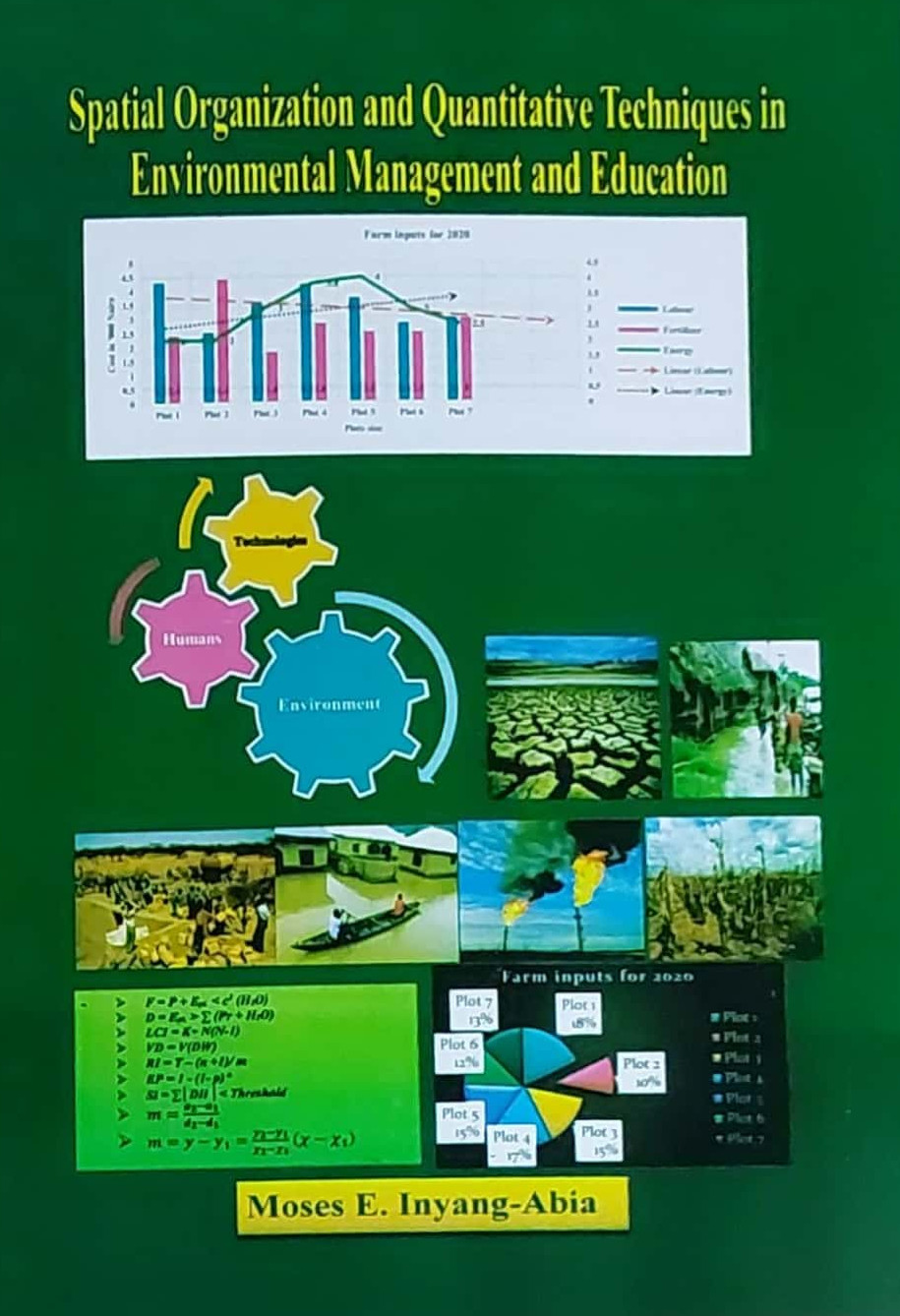Spatial Organization and Quantitative Techniques in Environmental Management and Education
$100.00
About the Book
The embers of the persistent and passionate desire to satisfy a major vacuum in the instructional ecosystem blossomed into a text which covers topics in the front burner of Environmental Management and Education. Before the 1980s, global attention had been drawn to the pressing need for sustainable development. What was the Millennium Development Goals (MDGs) had long metamorphosed into the Sustainable Development Goals (SDGs), sometimes code-named Vision 2030. The reality of the recent years exhibited by COVID-19 Pandemic partially emphasized the urgency for meeting the 17 MDGs as expressed in the169 targets and 247 indicators. Environmental Management and Education in recent years have attracted the global attention, not just because of the New Normal but more importantly because without making this Only One Earth sustainable, there may be no future world.
Author’s interaction with students and lecturers, over the years, at various levels dictated sincere yearning for simple, up-to-date and dependable source of information especially for the technical dimensions associated with Spatial Organization and the Quantitative dimensions of the environment, both in theory and practice. This book covers more than that as shown below.
The initial chapters focus on Human Ecology, Economy and Settlements; Technology, Society and Spatial Organization; The Environment, Science and Education; Objectivity and Rationale of Landscape Measurement in Environmental Management and Education. Closely following these are critical chapters on Measurement of Distances and Directions; Measurement of Physical Landscape: Map Scales, Distances, and Areas; Measurement of Weather and Climatic Elements; Measurement of Floods and Droughts and Measuring the Cultural Space and Technospheric Landscape. Spatial Technologies in Environmental Management and Education; Maps and Mapping Materials for the Environmentalist are also given adequate attention. Among others are the chapters which introduce statistics and apply them in simple terms. All over the text however, the relevant Quantitative Techniques are carefully introduced when deemed fit, so also are the Managerial Stunts and Maneuvers.
Other books by the Author include:
• Essentials of Educational Technology: A Handbook for Educators and Media Practitioners.
• Curriculum Dynamics and Professionalism in Teaching: An Introduction.
• Curriculum Technologies for Basic Education: Methods, Media and their Utilization.
• Curriculum Development and Evaluation in Environmental Education. (Co-authored)
• Environmental Education for Teachers. (Co-authored)
• Planning and Process in Environmental Management. (Co-authored)
• An Information Booklet for Environmental Education Unit. (Co-authored)
• Social Studies for Primary Schools in Cross River State. (1, 2 & 3) (Co-authored)
Description
Table of Contents
1. HUMAN ECOLOGY, ECONOMY AND SETTLEMENTS
1.1 Chapter Objectives
1.2 Human Settlement: Its definition and nature
1.3 Political Ecology: Definition and Growth
1.4 The City and Urbanization
1.5 View Points of the City
1.6 Human Ecology and Spatial Organizations
1.7 Urban Problems
1.8 The Future of Spatial Organization of Cities
1.9 The Role of Quantitative Techniques in Human Ecology, Economy and Settlement from the Perspective of the Environmental Manager and Educator.
1.10 Review Activities.
2. TECHNOLOGY, SOCIETY AND SPATIAL ORGANIZATION
2.1 Chapter Objectives
2.2 The Nature of Technology
2.3 Eco-technology Characteristics
2.4 The Core Principles of Eco-technology
2.5 Effects of Technology on Spatial Organizationand Human Ecology
2.6 Concepts of Community
2.7 Ferdinand Tönnies’ Gemeinschaft and Gesellschaft Philosophy
2.8 Community Development and Spatial Organization
2.9 Community Functions and Spatial Organization
2.10 Regulated Functions Influencing Spatial Organization of Settlements
2.11 Growth without Development
2.12 Review Activities
3. THE ENVIRONMENT, SCIENCE, MANAGEMENT AND EDUCATION
3.1 Chapter Objectives
3.2 The Environment
3.3 Science
3.4 Environmental Science and its Rationale for Environmental Education
3.5 The Role of Environmental Management in Environmental Sustainability Equation
3.6 Environmental Education or Environmental Science
3.7 Definitions of Environmental Education
3.8 Key Ecological Concepts for Environmental Education
3.9 Key Emphasis of Environmental Education
3.10 Main Areas of Focus of Environmental Education
3.11 Review Activities
3.12 Appendix to Chapter Three: A Copy of the Tbilisi Declaration(1977)
4. OBJECTIVITY AND RATIONALE OF LANDSCAPE MEASUREMENT IN ENVIRONMENTAL MANAGEMENT AND EDUCATION
4.1 Chapter Objectives
4.2 Measurement: Its Meaning and Objectivity
4.3 Measurement: Its Values and Rationale
4.4 Role of Data in Landscape Measurement, Management and Spatial Organization
4.5 Review Activities
5. MEASUREMENT OF DISTANCES AND DIRECTIONS
5.1 Chapter Objectives
5.2 Distances
5.3 Heights and Depths
5.4 Gradient and Slope
5.5 Geothermal Gradient and Lapse Rates
5.6 Directions and the Compass Points
5.7 The Tertiary (32-Point) Inter-Cardinal Points
5.8 The Angular/Compass Bearings
5.9 Types of Compass
5.10 Compass versus GPS for Navigation
5.11 Bearings and Meridians
5.12 Bearings and their Formats
5.13 Convertibility of Bearings
5.14 Measuring Bearings on the Map
5.15 The Concept of North
5.16 Measuring the Earth: Latitudes, Longitudes, the Great Circles and the Coordinates
5.17 Review Questions
6. MEASUREMENT OF PHYSICAL LANDSCAPE: MAP SCALES, DISTANCES AND AREAS
6.1 Chapter Objectives
6.2 The Concept of Scale
6.3 Types of Scale
6.4 The Linear or Plain Scale
6.5 Construction of the Linear or Plain Scale
6.6 Map Sizes and Map Scales
6.7 How Map Reduction and Enlargement Work
6.8 Calculation of
Distances and Areas on a Map
6.9 Calculation of Areas on a Map
6.10 When Map Scales are not Specified
6.11 The Graticule and the Grid Lines
6.12 Review Exercises
7. MEASUREMENT OF WEATHER AND CLIMATE ELEMENTS
7.1 Chapter Objectives
7.2 Temperature
7.3 Precipitation
7.4 Possible errors caused by wind in gauge readings
7.5 Newer technologies in precipitation monitoring
7.6 Pressure
7.7 Humidity
7.8 Wind
7.9 Sunshine or Solar Insolation
7.10 Clouds
7.11 Review Activities
8. MEASUREMENT OF FLOODS AND DROUGHTS
8.1. Chapter Objectives
8.2 What is Flood?
8.3 Factors that provoke flood
8.4 The Role of El-Niño and La Niña
8.5 Flood Stage and Crest
8.6 Flood Taxonomy, Characterization and Impacts
8.7 Flood Measurements and Instrumentation
8.8 Flood Prediction Process
8.9 Drought: A Preview
8.10 What is Drought?
8.11 Causes of Drought
8.12 Levels of Severity of Drought and their Impacts
8.13 Measurements of Droughts
8.14 Drought Typology
8.15 Drought Phenomenon Indicators for Assessment and Management
8.16 Drought Risk Analysis, Monitoring and Prediction
8.17 Review Activities
9. MEASURING THE SOCIOCULTURAL AND TECHNOSPHERIC LANDSCAPES
9.1 Chapter Objectives
9.2 Concepts Clarification
9.3 Relevance of Measurements to Sociocultural and Technospheric Landscapes
9.4 Guidelines for recording data in the field during a landscape survey
9.5 Vegetation Survey Methods
9.6 Equipment
9.7 Insect and Animal Survey
9.8 Traffic Survey and Monitoring Systems
9.9 Indicators and Indices
9.10 Some Common Indicators/Indices and their Measures
9.11 Human Development Index (HDI)
9.12 Human Freedom Index (HFI)
9.13 Global Multi-Dimensional Poverty Index
9.14 Location Quotients (LQ)
9.15 Computation, Interpretation and Application of Location Quotient
9.16 Nearest Neighbours Indices (NNIs)
9.17 Computation of Nearest Neighbours Indices (NNI)
9.18 Application of Nearest Neighbours Index (NNI)
9.19 Review Exercises
10. SPATIAL TECHNOLOGIES IN ENVIRONMENTAL MANAGEMENT AND EDUCATION
10.1 Chapter Objectives
10.2 Definition of Technology
10.3 Characteristics of Technology
10.4 Objectives of Technology
10.5 Spatial Technologies and Spatial Information Technologies
10.6 Geographic Information Science/System (GIS)
10.7 Global Positioning System (GPS)
10.8 Remote Sensing (RS)
10.9 Satellite Imagery
10.10 Spatial Data Management (SDM)
10.11 The Google Earth
10.12 The Drones Technology
10.13 Review Questions
11. MAPS AND MAPPING MATERIALS
11.1 Chapter Objectives
11.2 Maps: Definition and
Cartographic Elements
11.3 The Concept of Map Projections
11.4 Types of Maps
11.5 Classification of Maps
11.6 Mapping Materials
11.7 Review Exercise
12. FIELD DATA, INFORMATION DOCUMENTATION AND REPORTING
12.1 Chapter Objectives
12.2 The Role of Spatial Data and Information in Environmental Management and Education
12.3 Critical Success Factors(CSFs)
12.4 Key Performance Indicator (KPI)
12.5 The Rubrics and their Design
12.6 Sampling for field data and information
12.7 Spatial Data and Information Recording Formats
12.8 Reporting Field Observations
12.9 Review Questions
13. INTRODUCTORY STATISTICS AND TECHNIQUES
13.1 Chapter Objectives
13.2 Statistics: Meaning and Background
13.3 Divisions of Statistics
13.4 Parametric and Non-parametric statistics
13.5 Reasons for use of statistics in Environmental Management and Education
13.6 Rationale for Use of Inferential Statistics in Environmental Management and Education
13.7 Functional Roles of Statistics in Environmental Management and Education
13.8 Statistics and Decision Making
13.9 Review Questions
14. SOME STATISTICAL CONCEPTS AND APPLICATIONS
14.1 Chapter Objectives
14.2 Population
14.3 Sample
14.4 Sampling Types and Techniques
14.5 Merits and Demerits of Major Sampling Techniques
14.6 Concepts and Constructs
14.7 Variables
14.8 Scales of Measurement
14.9 Research Design, Research Method and Research Methodology: Some Categorical Errors
14.10 The Mixed-Method and Multimethod Operational Studies of the Environment
14.11 Review Questions
14.12 Appendix to Chapter 14(Table of Random Figures)
References
Index

Prof Moses Inyangabia
INYANG-ABIA, Moses, is a Professor of Curriculum Technologies and Environmental Education, Faculty of Education, University of Calabar. He holds a PhD (UNICAL: Curri Tech – 2000); CFS (Strathclyde: Environmental Edu -1990); MA (UNIFE: EduTech -1984); BA (UNICAL: Edu/Geo -1980). He was Director, Institute of Education ( 2006 – 2007); Provost,). Current research focus includes Integration of New Instructional Technologies and Grassroots Climate Change Mitigation Strategies.
His last two national outings were Lead Presentations at the Nigeria’s Centenary Celebration organized by NEST at the University of Ibadan, Nigeria, September 24-25, 2014; and the Broad-based Multi-Sector National Education Summit organized at Abuja, Nigeria, by Academic Staff Union of Universities (ASUU) in collaboration with other Campus Unions and Civil Society Groups, 27-31 October, 2014.
Professor Inyang-Abia has travelled extensively, having been to all states of the federation and three continents of the world. He is, by the Grace of God, a Christian to the core. He is happily married to a Princess, Dr. (Mrs.) Eme Inyangabia. They are blessed with many children, in-laws and grandchildren. His major hobbies include reading, writing, conservation activities, religious activities and table tennis. He is a silent achiever
Click here to visit his personal knowledgebase.
Questions and Answers
You are not logged in
